The highest rate of nutrient absorption in deciduous trees occurs between flowering and rapid vegetative growth. Root growth in cherry trees begins when soil temperatures approach 15°C in spring, usually after flowering (under Washington State conditions).
According to Artacho and Bonomelli (2016), growth - in the case of the Gisela 6 rootstock - starts about 30 days after flowering (DDPF), while the highest rate of fruit growth, associated with the cell division phase, occurs between 21 and 28 DDPF.
These results confirm that initial growth: flowering, pollen tube growth, leaf area, early shoots, and fruit growth depend on the accumulated reserves in the roots, buds, and wood. Therefore, fertilization with mobile nutrients must be timely to minimize losses.
One of the main aspects to consider when developing a fertilization program is determining what nutrients the crop needs and when. A simple approach to answering the first question is to define the nutrient requirements of the trees and the crop based on the estimated yield and adjust the quantities considering soil inputs, amendments, and irrigation water.
However, the when is closely related to the cycle of each nutrient in the soil and plant. For mobile elements, such as nitrogen (N), the timing of absorption is an important consideration, whereas for immobile elements, such as phosphorus (P), timing is less relevant.
For Nitrogen (N), due to its mobility, all sources need to be considered
Nitrogen is a mobile nutrient both in the soil and in the plant. The requirement for this element in cherry trees is normally higher than what the soil and water can provide, especially in high-yield orchards. The N requirement for cherry trees ranges from 1.2 to 6.5 kg per ton of fruit (Geisseler, 2016, adapted from Fallahi et al. 1993, Silva and Rodriguez, 1995).
In 2022, Sallato and Whiting (unpublished) updated the nutrient extraction values for cherry varieties “Chelan,” “Skeena,” and “Coral Champagne” (Table 1).
| Table 1. Nutrient extraction in kilograms (kg) of nutrients per ton of fruit produced |
|---|
| Nutrient | Kg/ton |
| Nitrogen (N) | 1.9 - 2.2 |
| Phosphorus (P) | 0.3 - 0.4 |
| Potassium (K) | 1.9 - 2.7 |
Calcium (Ca)
| 0.1 - 0.2 |
| Magnesium (Mg) | 0.09 - 0.2 |
| Sulfur (S) | 0.1 |
| Updated by Sallato and Whiting, 2022, for Chelan, Skeena, and Coral Champagne. No significant differences were observed among the cultivars. |
Diagnosis: A nitrogen deficiency manifests as stunted growth, generalized chlorosis (yellow leaves), and small fruit (Figure 1). An excess or toxicity leads to exuberant vegetative growth, delayed harvest, and poor fruit quality. Symptoms first appear on the older leaves.
Leaf analysis of total N is a good indicator of nutrient excess or deficiency, but it should be noted that the N concentration in leaves starts very high (around 3%) and then steadily decreases to below 1.0% during the fall. Therefore, to use leaf analysis as an indicator, it is important to sample mature leaves from recently and non-fruiting shoots of the season. Soil analysis for N content (NO3 or NH4) is not a good predictor of N requirements.
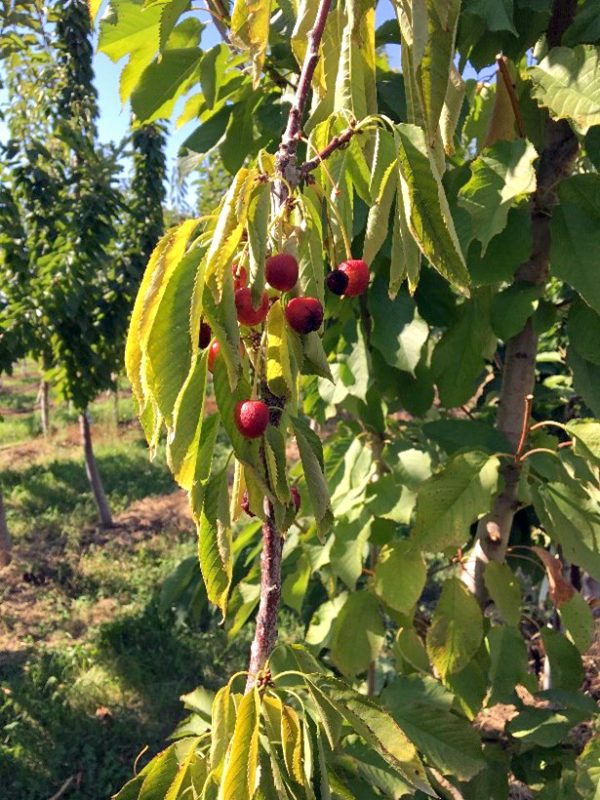 Immagine 1: Chlorotic cherry leaves.
Immagine 1: Chlorotic cherry leaves.
Management: Trees take up N as nitrate (NO3) and ammonium (NH4). One approach is to calculate the N requirement based on the expected yield (Table 1). It is necessary to consider all possible sources in the system. The most important contribution to the soil comes from organic matter (OM).
A reasonable estimate considers 4.5 kg of N for each percentage point of OM in the soil. In some areas, irrigation water is an important contributor of N in the form of NO3 (readily available to the plant), and its quantity can be determined through laboratory analysis.
Thus, the total demand minus the combined inputs will provide an estimate of the required dose. It is important to remember that N is a highly mobile element, so significant losses can occur that affect the efficiency of application.
Considerations: For more readily available inorganic products (urea, calcium nitrate, monoammonium phosphate, etc.), it is advisable to split the application from petal fall until a month before harvest. Excessive N applications just before harvest can slow down coloring and delay the harvest.
If trees are too vigorous or the fruit load is low (due to frost or pollination issues), the requirements should be adjusted. Fall foliar applications of N can help build reserves for the next season, but soil applications of N during the fall are not recommended.
Phosphorus (P), very immobile in the soil, but highly mobile in the plant
Plants absorb P as H2PO4, an active process requiring energy. The demand for P in a cherry orchard is low compared to N and K. According to Silva and Rodriguez (1995), the requirement in cherry orchards is about 0.3 kg of P per ton of fruit (0.71 - 0.86 pounds/US ton). 1 US ton = 0.90719 t. Some soils have low levels of available P, especially clay soils in deeper areas, which can partially explain the range of values reported in Table 1.
Diagnosis: A deficiency can reduce or delay growth and lead to a dark red coloration of leaves due to increased anthocyanin pigments. Since P is so mobile in the plant, deficiencies first appear in the older leaves (Figure 2).
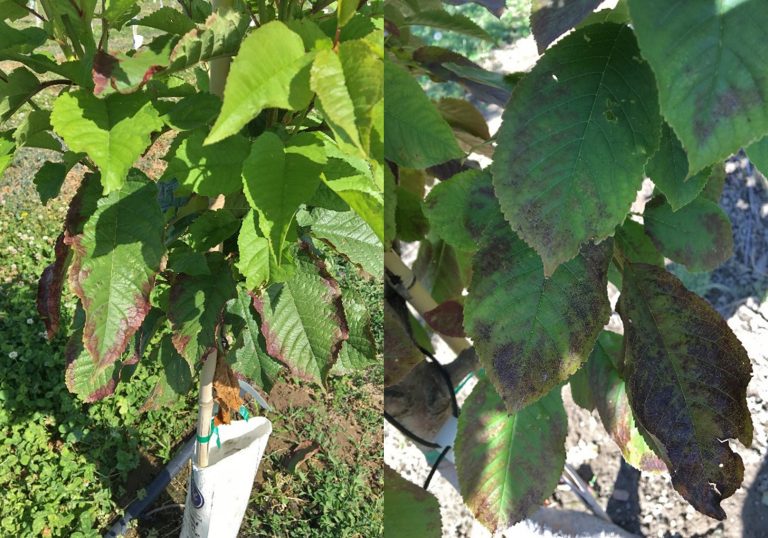 Immagine 2: Cherry leaves with K deficiency symptoms (left) and K and P deficiency (right). Photo: B. Sallato.
Immagine 2: Cherry leaves with K deficiency symptoms (left) and K and P deficiency (right). Photo: B. Sallato.
Management: The P-Olsen soil test is a good indicator of P availability. Soil levels should be maintained between 15 and 40 mg/kg. If P-Olsen levels are below 15 mg/kg, a single application of 45 kg of H2PO4- per hectare will provide sufficient phosphorus for a couple of seasons (40 lb/acre). 1 lb = 0.45 kg; 1 acre = 0.405 ha.
If levels are too low (less than 5 mg/kg), correcting P levels in the soil will take several years. Due to its low mobility in the soil, P can be applied at any time during the season and all at once, without risk of losses.
However, the same lack of mobility makes deep soil movement difficult, which can lead to deficiencies when the fertilizer does not reach the root zone. For this reason, the best time for P fertilization is during soil preparation before planting.
Considerations: P availability in the soil is limited to pH levels below 6.5 and above 7.5. Proper pH management will improve overall nutrient availability. If P levels are high or adequate in the soil but low in the plant, problems may be related, among other things, to mimicking nematodes, pathogens, excess or lack of water, or poor root health.
Potassium (K), its mobility depends on soil type
The mobility of K in the soil depends on the soil texture and cation exchange capacity (CEC). K can be very mobile in sandy soils and leach out of the root zone, especially under high irrigation conditions. In heavier soils (clay, loamy, or clayey) K has low mobility and can accumulate over the years. K is highly mobile in the plant, and the estimated requirement is 1.9-2.7 kg/t of fruit (4.2-6.0 pounds/t, Table 1).
Diagnosis: A deficiency first appears in the older leaves with yellowing or necrosis of leaf margins (Figures 2 and 3). Low K levels have also been associated with small fruit and low soluble solids content. There have been no reports of toxicity, but excessive levels of K in the soil can antagonize the absorption of calcium and magnesium, leading to nutrient imbalances and reduced fruit quality.
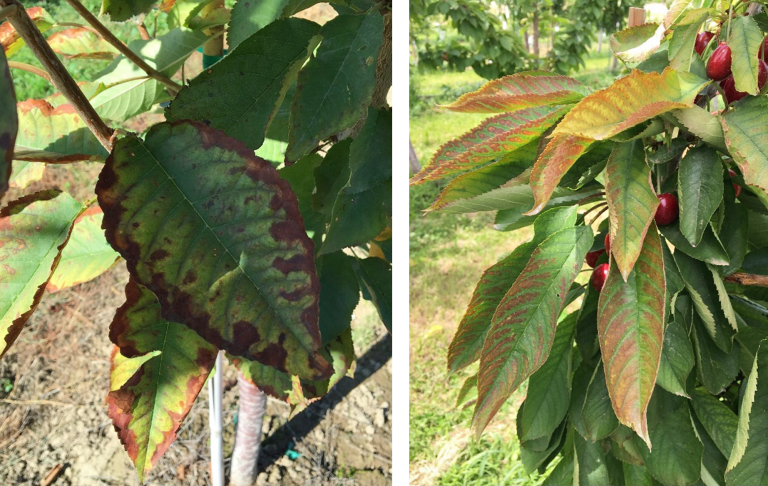 Image 3: Magnesium and potassium deficiency symptoms in cherry trees. Photo. B. Sallato. 2016.
Image 3: Magnesium and potassium deficiency symptoms in cherry trees. Photo. B. Sallato. 2016.
Management: Although deficiencies are rare, excessive levels of the element have been reported in some production areas. It is advisable to maintain levels between 150 and 300 mg/kg (exchangeable K). If levels exceed 300 mg/kg in cherry trees, no K application is needed.
If levels drop below 150 mg/kg, correction is needed by applying 136 kg of K2O per hectare (120 lb/acre). Nutrient levels should be checked the following year to adjust the required dose. Timing of application is not critical on clay or heavy soils (as with P), but on sandy soils it is better to distribute applications throughout the spring (as with N).
Considerations: K excess can be found in all types of soils, including sandy ones, if they have variable texture along the profile, a condition that prevents the leaching of the element. Manure and compost may contain high levels of K, so it is advisable to analyze their composition in a laboratory.
If soil K is adequate or high but plant levels are low, there may be an absorption limitation. For example, nematodes, pathogens, lack or excess of water, or root diseases. When there are limitations in root absorption, foliar applications are justified for a period, but they are not a permanent solution to the problem.
Calcium (Ca), associated with cracking and fruit firmness
The mobility of calcium in the soil depends on the texture and Cation Exchange Capacity (CEC). In coarse sandy soils, Ca can be mobile and leach out of the root zone, especially with excessive irrigation. In heavy soils (clay, silt, or clayey), Ca is less mobile and can be retained by the soil’s negative charges and organic matter.
There are soils with high amounts of Ca (over 10 meq/100 g), typically associated with high pH and the presence of carbonates or silt (CaCO3). Although Ca availability is reduced in soils with high pH (above 9.5) or acidic soils (below 5.5), the available portion in the root zone is in constant equilibrium with the unavailable portion. In situations with high levels of Ca (over 8 meq/100g), adding more Ca does not improve absorption.
Irrigation water can also contain high levels of Ca and CaCO3, which can contribute to the Ca available to plants. For plant needs, Ca requirement is estimated between 0.14 and 0.18 kg per ton of fruit (0.3 - 0.4 pounds per US ton).
Diagnosis: Calcium is part of the cell wall and is crucial for its strength. In cherry trees, calcium deficiency has been linked to cracking and fruit firmness (Demarty et al., 1984, Christensen, 1996).
In contrast, fruits with high levels of Ca have reduced cuticle permeability (Christensen, 1996) and greater cell wall strength (Glenn and Poovaiah, 1989). Although Ca has long been associated with fruit firmness, its relationship with fruit quality and post-harvest life is contradictory and still to be proven.
Management: While leaf tissue analysis is a good tool for determining uptake, it is not directly correlated with Ca uptake by fruits. Various factors, in addition to Ca supply, can impede Ca transfer to fruits, such as excess N and vegetative growth, shading, stress conditions, etc.
If leaf levels are deficient, it is likely that fruit levels are also deficient, but an adequate Ca level in leaves does not necessarily indicate adequate levels in fruits.
Standard exchangeable Ca analysis is a good tool for determining soil Ca availability. If soil levels are below 4 meq/100g or 800 mg/kg, they can be corrected with soil applications during the spring. Several commercial products provide different forms of Ca.
Gypsum (CaSO4) is an economical source of Ca that also provides sulfur. If N levels are low, CaNO3 is also a good alternative. If there are no salinity issues in the soil, CaCl2 is a cost-effective alternative for conventional growers.
Although foliar applications are not as effective as soil applications, there are some exceptions that justify foliar applications of Ca:
- Excessive potassium levels in the soil (over 300 mg/kg or ppm).
- Cold and dry soils before full bloom (15°C).
- Limitations of the root zone: pathogens, physical limitations, excess or lack of water, nematodes, etc.
Although pre-harvest applications of Ca to reduce rain cracking are common in cherries, results are mixed. Post-harvest, soaking fruits in a CaCl2 solution is widely recognized as a treatment to reduce cracking and prolong peduncle greenness (Wang and Long, 2015).
Wang and Long (2015) recommend a CaCl2 solution of 0.2-0.5% (equivalent to 2,000-5,000 ppm of CaCl2) for 5 minutes followed by a cold water (0°C) dip for 15 minutes to increase firmness and shine of the skin and reduce the incidence of cracking and browning of the peduncle.
Considerations
- The maximum Ca uptake in cherry occurs in spring, about 25 days after full bloom, with new root growth.
If soil pH is above 8.5 or there is a high CaCO3 content, it is better to manage the pH rather than add more Ca to the soil. In sodic soils (high sodium - Na levels), gypsum (CaSO4) applications remove excess Na and improve soil structure. Good drainage is necessary. CaCl2 is not recommended for saline or poorly-drained soils (impermeable layers).
Magnesium (Mg), moderate plant mobility
The mobility of the element in the soil depends on soil texture and Cation Exchange Capacity (CEC). In heavy sandy soils, Mg can be mobile and leach out of the root zone, especially under conditions of heavy irrigation. In heavier soils (clay, silt, or clayey), Mg can be fixed in soil particles.
Like Ca, deficiencies can occur in sandy soils with excessive drainage. Mg has moderate mobility within the plant. The plant requirement is estimated to be between 0.09 and 0.18 kg per ton of fruit (0.2 - 0.4 pounds/US ton, Table 1).
Diagnosis: Deficiency symptoms first appear on older leaves as interveinal chlorosis, which can lead to interveinal necrosis (Figure 3). Leaf tissue analysis is a good indicator of Mg uptake by the plant in general and by fruits in particular.
Management: In case of deficiency, soil levels should be corrected by applying 30 lbs of MgSO4 (magnesium sulfate). If root absorption is limited by excess K, foliar applications of MgSO4 can be effective in mitigating the deficiency. As with nearly all nutrients, the peak uptake period is spring and rapid vegetative growth.
Considerations:
- Excessive K levels in the soil, above 300 mg/kg or ppm, can hinder Mg absorption.
- Excessive CaCO3 or CaSO4 applications can impede Mg absorption.
Sulfur (S), deficiencies that can be corrected
Sulfur is a mobile element both in the soil and in the plant. Although deficiencies can occur in various soil types, they can be easily corrected.
Diagnosis: Leaf deficiency symptoms are very similar to those of N deficiency, with a generalized yellowing of the leaves, which are also smaller. Leaf tissue analysis is useful for diagnosing the deficiency.
Management: For low levels of the element in the soil, fertilizers containing sulfate, such as CaSO4, MgSO4, ZnSO4, etc., can be applied to improve SO4 levels. The application of gypsum can simultaneously correct S and Ca deficiencies.
Considerations: Leaf burn can occur if applied foliarly at temperatures above 29.5°C.
Boron (B), essential for root and shoot growth
Although B is mobile in the soil, it is not very mobile in the plant. Recent surveys of over 170 soils in Washington State found all samples to be deficient in B (less than 0.5 mg/kg) (Sallato, unpublished). Its availability can be limited in pH ranges between 7.0 and 8.5, a common situation in the area where the soil surveys in Washington were conducted. Other factors that can limit B uptake include cold or dry soil conditions in spring.
Diagnosis: B is essential for meristematic growth of roots and shoots, so a very characteristic symptom is the death of the tips of new shoots. It is also important for pollen tube elongation during the pollination process, so deficiency can affect fruit set and yield. B tests in leaf tissues are a good indicator of overall uptake but are not well correlated with B levels in fruits.
Management: It is advisable to maintain adequate levels of B in the soil (between 0.5 and 1.5 mg/kg). In deficient sites, it is highly recommended to apply B in the spring or at the end of dormancy. The application rate must be calculated carefully, as toxicity can easily occur even with reduced doses.
Iron (Fe), Manganese (Mn), Copper (Cu), and Zinc (Zn)
Despite the low demand for these nutrients, they are essential for fruit growth, development, and quality. Deficiencies are often related to poor availability due to high soil pH or anoxia in the root zone (excess water and lack of oxygen), conditions where soluble forms of these elements precipitate and become unavailable to plants.
Diagnosis: Visual symptoms of Zn and Fe deficiency are clearly distinguishable. Zn deficiency results in blind wood (“blind”), small rosette leaves with short internodes. Fe deficiency is characterized by yellowing of the entire leaf (Figure 4). High soil pH primarily affects Fe availability, which can develop symptoms that mask other deficiencies. Symptoms start on young leaves.
Mn and Cu deficiencies are less evident and often remain hidden. The best diagnostic tool for these elements is soil pH measurement and consideration of visual symptoms.
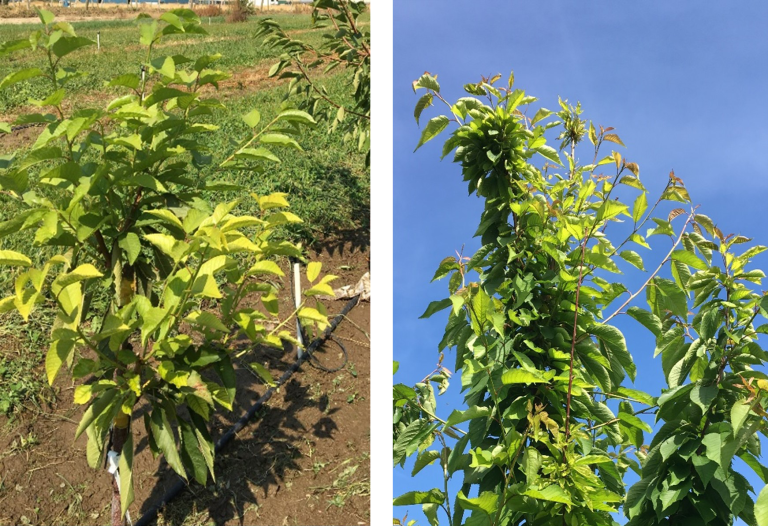 Immagine 4: Symptoms of Fe deficiency (iron chlorosis) (left) and Zn deficiency (right) in cherry trees. Photo: B. Sallato.
Immagine 4: Symptoms of Fe deficiency (iron chlorosis) (left) and Zn deficiency (right) in cherry trees. Photo: B. Sallato.
Management: When deficiencies of metal micronutrients are due to high soil pH, correcting the levels of these elements in the soil is not effective, although good results have been obtained by applying chelated elements during the growing season.
The best practice is to manage soil pH to improve the availability of micronutrients in the profile. Foliar applications of Zn during spring or late dormancy have also been successful. Due to its low mobility in the plant, frequent applications are more effective when deficiencies occur during the growing season.
Leaf tissue analyses are very useful for monitoring adequate uptake or whether trees are in conditions of deficiency or excess. Visual symptoms can also be helpful for diagnosing deficiencies or excesses, but it is important to consider that symptoms may be confused with other issues.
Among others, pests, diseases, pesticide toxicity, or stress due to lack or excess of water, wind, or heat (Figure 5). A proper diagnostic process should consider alternative tools (soil and tissue analyses).
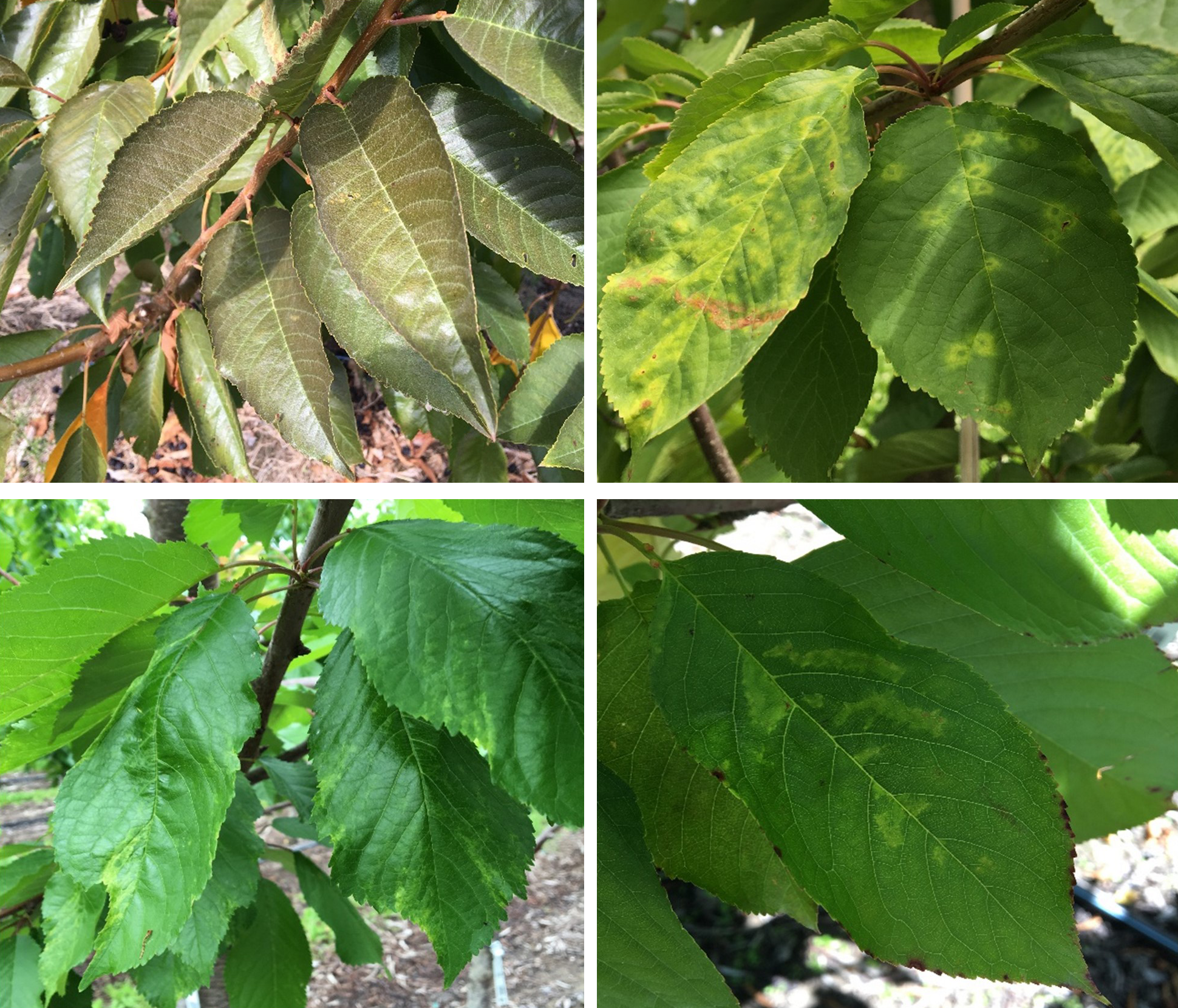 Image 5: Symptoms not related to nutritional problems. Top left, browning of leaves due to mite attack. Top right, dwarfing virus (PDV). Bottom left, wrinkled leaf disease. Bottom right, symptoms of virosis in the cherry tree.
Image 5: Symptoms not related to nutritional problems. Top left, browning of leaves due to mite attack. Top right, dwarfing virus (PDV). Bottom left, wrinkled leaf disease. Bottom right, symptoms of virosis in the cherry tree.
Today’s leaf tissue standards do not account for fruit quality
Nutritional management of cherry trees is based on leaf tissue standards, which are very useful for preventing deficiencies or toxicity. These standards have been developed to determine nutrient concentrations during the peak growth period, without considering the quality or storability of the fruits (i.e., there are no nutritional standards aimed at optimizing fruit quality).
Last year, Washington State University commissioned Sallato, Whiting, and Torres to start a three-year project titled “Nutritional Managements for High Quality Cherries,” funded by the Washington Fruit Tree Research Commission (WT-FRC) and the Oregon Cherry Commission (OSCC).
The project's goal is to improve management strategies to produce better quality fruit and storability. The project is expected to provide a better understanding of the relationship between fruit quality and nutrient composition, as well as specific extraction values for each variety.
Source: Redagrícola
Images: Redagrícola
Cherry Time - All rights reserved
















